
by Kate S. Zalzal Tuesday, January 9, 2018
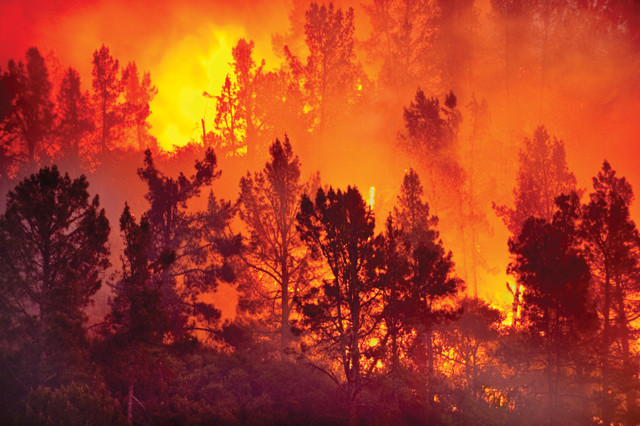
For hundreds of millions of years, wildfires have shaped the planet. Credit: Naomi Kelly.
We owe Earth as we know it to fire. Fire-prone ecosystems cover 40 percent of the land surface today, and fires play a key role in maintaining many of the world’s major biomes, including grasslands, savannas, shrublands and boreal forests. It’s thought that global forests would double in extent in the absence of fire.
For hundreds of millions of years, wildfires have shaped the planet, from the plants, animals and ecosystems around us to the air we breathe. Yet scientists are only beginning to understand fire’s history, especially how it has both influenced and been influenced by the atmosphere, plant evolution and changing climates through geologic history. As we learn more about fire’s essential role in maintaining modern ecosystems, researchers are looking to the past to further understand the mechanisms and magnitude of fire’s relationship with Earth.
For most of Earth’s history, however, wildfires were nonexistent; the conditions required for fire to propagate simply did not exist. The process and timing of the onset of fire-favoring conditions and the subsequent impacts on the atmosphere, land and oceans are areas of growing interest. And scientists are increasingly uncovering feedbacks within and between these critical earth systems, and finding that fire plays a role in many of them. A growing body of evidence, obtained in recent years from studies of ancient charcoal, the fossil record and laboratory burn experiments, as well as from biogeochemical modeling, demonstrates that wildfires may have had a more profound impact than previously imagined.
But the details are far from settled. Without more data, particularly a better understanding of the charcoal signals that fires leave behind, it remains difficult to fully resolve the history and complex impacts of ancient wildfires. Nonetheless, recent research now points toward fire driving and sustaining key evolutionary innovations that spurred biodiversity and played a role in extinction events. Scientists also think that fire may ultimately be responsible for maintaining oxygen levels in our atmosphere within a range that supports life, including large, terrestrial organisms, such as humans.
The oldest evidence of wildfire comes from a 420-million-year-old rhyniophytoid plant, a small leafless plant from the Silurian Period, whose charred remains were found in an English siltstone. Charcoal, soot, polyaromatic hydrocarbons and evidence of fire scars in tree rings are the typical evidence of fire, with charcoal, usually found in sedimentary rocks, being the most useful in studies of deep time. Scientists broadly correlate charcoal abundance with the frequency and extent of fire activity: the more charcoal present in the fossil record, the more fire is inferred to have been on the landscape. These records indicate that, while fire has been a presence throughout most of the past 420 million years, the extent of fire activity has varied considerably over this period.
To understand why some periods were more fiery than others and what this means for earth systems, it helps to look at what ignites and propagates wildfires, says Timothy Lenton, an earth system scientist at the University of Exeter in England. By definition, fire is an exothermic oxidation reaction dependent on the rapid combination of fuel and oxygen.
Volcanic activity, meteorite impacts, sparks from rock fall and spontaneous combustion can all provide the initial spark, but lightning is the most prevalent trigger. Terrestrial vegetation is the most common wildfire fuel. Vegetation characteristics — such as whether the fuel consists of tree trunks, leaves, duff or peat, and whether it’s wet or dry — determine if a spark will turn into a fire and exactly how it will propagate. And, of course, oxygen, which has been present in the atmosphere for at least a couple of billion years, but not always at today’s levels, is the third necessity.
The charcoal record shows that by 420 million years ago, these three ingredients — a spark, fuel and oxygen — were available in sufficient quantities such that fire became a presence on the landscape. The timing of Earth’s earliest flammability provides a key insight into the atmospheric oxygen content, a trait that Lenton calls one of the “master variables” of the earth system.
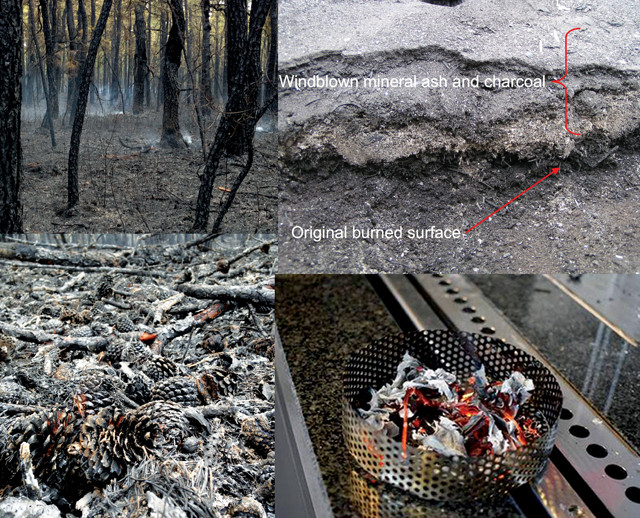
Looking at how fires burn today in the field and in the lab helps researchers uncover clues as to how they burned in the past. Not all vegetation burns the same way, and researchers can see charcoal remains from fires left on the forest floor after a fire. In some fires, for example, some vegetation is turned into white mineral ash, which can be differentiated from charcoal. Furthermore, under a hand lens or microscope, a wide range of different fragments of charred remains can be identified. Credit: clockwise from top left: Claire Belcher; Deborah Martin, USGS; Stacey New, wildFIRE Lab; Claire Belcher.
At the wildFIRE Lab at the University of Exeter, earth system science professor Claire Belcher and her students and colleagues continue to flesh out this relationship by further refining the limits of oxygen necessary to support natural fires, a range referred to as the “fire window.”
They have found that fires, even if ignited, will not propagate if the atmospheric oxygen concentration is below 16 percent. At our modern oxygen level of 20.9 percent, fires ignite and propagate readily. And at levels of 23 percent and higher, fires become more frequent, widespread and incredibly destructive. At these high levels, “anything that could create a spark could potentially set alight all but the wettest fuel,” Lenton says.
Belcher’s team’s work indicates that while there is not a firm upper limit to the fire window, 30 percent is a practical limit. Burn prevalence increases only slightly between 23 and 30 percent oxygen, and fuel moisture plays an important role too. It would only be possible to have periods with atmospheric oxygen concentrations approaching 30 percent (and preserve terrestrial vegetation) if Earth were much wetter than today.
Based on these fire window parameters, Belcher and her colleagues also created a model, called FIREOX, which predicts burn probabilities as a function of atmospheric oxygen. The model indicates that burn probabilities remain low until atmospheric oxygen reaches 19 percent, then rapidly increase at 21 percent before plateauing at about 23 percent oxygen.
Atmospheric oxygen has fluctuated throughout the past 500 million years, and while researchers have pieced together rough outlines of past levels, the details of these fluctuations remain unclear. In addition to their influence on Earth’s flammability, the timing and degree of oxygen fluctuations have implications for a range of other earth science questions. “Hypotheses have been proposed to correlate atmospheric oxygen fluctuations with mass extinction events and the evolution of various traits in animals, including gigantism in insects and sauropods, the evolution of placental mammals, and flight in insects, birds, bats and pterosaurs,” says Ian Glasspool, a research scientist at Colby College in Maine and research associate at the Field Museum of Natural History in Chicago, Ill. “But testing of such hypotheses is severely constrained by our imprecise knowledge of the atmospheric oxygen concentrations in deep time,” he says.
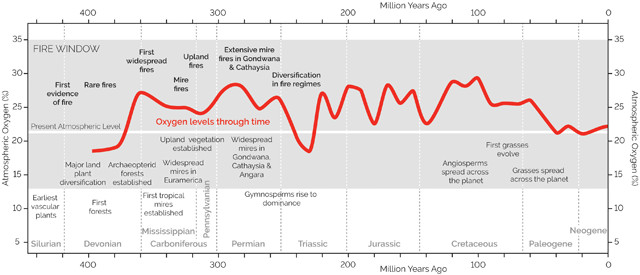
Recent research suggests that the Carboniferous (359 million to 299 million years ago), Permian (299 million to 252 million years ago), and Cretaceous (145 million to 66 million years ago) had elevated oxygen concentrations, with levels above 26 percent through most of these periods, and wildfire activity significantly higher than today. The Early to middle Late Triassic (252 million to 220 million years ago) was a period of very low oxygen — even dipping below 20 percent — with evidence for little to no fire activity at all. From the middle of the Late Triassic through the Jurassic (220 million to 145 million years ago), oxygen and fire activity appear to have fluctuated but still remained higher than modern levels. Since the Cretaceous, the oxygen level declined steadily from at least 26 percent to about 21 percent, where it appears to have remained with little variability for the last 55 million years. Credit: K. Cantner, AGI.
This is where the fossil charcoal record and our understanding of the fire window can help. “We know variability in atmospheric oxygen concentration has a profound impact on fire occurrence, and this should show up in the fossil charcoal record,” Lenton says.
Glasspool, along with Andrew Scott, a paleobotanist at Royal Holloway, University of London, collected fossil charcoal data as a proxy for wildfire prevalence and, in a 2010 paper published in Nature Geoscience, reconstructed atmospheric oxygen concentrations for the past 400 million years. Their work, along with Belcher’s, identifies the Carboniferous (359 million to 299 million years ago), Permian (299 million to 252 million years ago), and the Cretaceous (145 million to 66 million years ago) as periods of elevated oxygen concentration, with levels above 26 percent through most of those periods, and wildfire activity significantly higher than today. The Early to middle Late Triassic (252 million to 220 million years ago), meanwhile, was a period of very low oxygen — even dipping below 20 percent — with evidence for little to no fire activity at all. From the middle of the Late Triassic to the Jurassic (220 million to 145 million years ago), oxygen and fire activity appear to have fluctuated but still remained higher than modern levels.
Since the Cretaceous, the oxygen level declined steadily from at least 26 percent to about 21 percent, where it appears to have remained with little variability for the last 55 million years. In her 2013 book, “Fire Phenomena and the Earth System: An Interdisciplinary Guide to Fire Science,” Belcher notes that this relatively stable modern level falls within the range where the most rapid changes in burn probability occur, as identified by her FIREOX model. Around the modern level of 20.9 percent, even small shifts in atmospheric oxygen concentration have significant impacts on the likelihood that fuel will burn. “This may speak volumes about the role that fires play in maintaining many aspects of the earth system,” she wrote.
What controls atmospheric oxygen, and what has kept it within this relatively narrow range for so long, is a matter of debate. The first widely acknowledged fossil evidence of life appears at around 3.5 billion years ago; some of these early organisms are thought to have been oxygen-producing blue-green algae (cyanobacteria). But for the next billion years or so, any free oxygen they produced was consumed by chemical weathering, and the atmosphere and oceans remained largely anoxic. Eventually, oxygen production became sufficient to allow it to build up in the atmosphere, prompting the sudden rise in atmospheric oxygen known as the Great Oxidation Event, which occurred about 2.45 billion years ago, according to current thinking.
With oxygen finally floating freely in the atmosphere — albeit still at extremely low levels for much of the next 2 billion years — the stage was set for the evolution of more complex life. By about 540 million years ago, planktonic algae were diverse in the world’s oceans and there was enough oxygen to support the first marine animals. By 470 million years ago, plants had moved from the seas onto land. Scientists debate exactly when Earth’s atmosphere first approached a near-modern level of greater than 10 to 15 percent, with some suggesting it was more than 540 million years ago, well before plants moved to land, while others hypothesize that it was as much as 100 million years later.
In a 2016 study in Proceedings of the National Academy of Sciences, Lenton and his co-authors used a biogeochemical model to investigate relationships between carbon isotopes in marine records, fossil charcoal and plant evolution. They concluded that the rise of the earliest land plants had caused a major oxygenation event in Earth’s atmosphere and oceans by 400 million years ago. This rise “tipped the earth system out of the previous low-oxygen regime,” Lenton says, “and into one in which we think fires and their effects on vegetation then played a crucial role in establishing and stabilizing a high-oxygen regime.” But identifying the mechanism that maintained this stability remains a challenge, he says.
On short timescales, plant photosynthesis, respiration and decomposition regulate atmospheric oxygen. On a geologic timescale, however, weathering of continental rocks, which consumes oxygen, and the burial of organic carbon, which leaves oxygen behind as a net source to the atmosphere, are the primary controls. Lenton thinks that because of the near endless supply of rocks to weather, oxygen production, rather than oxygen removal, plays a greater role in the regulation of atmospheric composition today. What, then, controls organic carbon burial, and is there a feedback between this and variations in atmospheric oxygen?

Charred plant remains provide clues to past climates, atmospheric composition, fire activity and plant evolution. From left to right: Early Devonian Rhyniophytoid; Pennsylvanian seed from cave fill; Cretaceous fern; Triassic wood; Cretaceous flower. Credit: Cretaceous fern: Field Museum of Natural History; rest: Ian Glasspool.
Lenton and Lee Kump, a biogeochemist and dean of the College of Earth and Mineral Sciences at Penn State University, suggest that the phosphorus cycle has a hand in controlling organic carbon burial, and that the feedback comes from fires. Phosphorus is released through rock weathering, and plants then take it up as a nutrient. “Phosphorus is basically the ultimate limiting nutrient for how much primary productivity you can have on the planet,” Lenton says.
The idea, initially proposed by Kump in a paper in Nature in 1988, is that if oxygen levels go up (for any number of reasons, such as changes in tectonic activity, climate or plant evolution), fires would then increase in frequency, severity and extent. This would impact terrestrial vegetation as burn frequency and extent increased and led to the suppression of new plant growth. The ultimate result, Kump and Lenton say, would be twofold: Less phosphorus overall would then be bioavailable, and more of the phosphorus that is present would move from land into the oceans. This shift matters because it changes where and how organic carbon is buried, thus changing the amount of oxygen produced and eventually released to the atmosphere.
Terrestrial plants have much higher carbon-to-phosphorus ratios compared to marine algae; for every bit of phosphorus, terrestrial plants contain at least 10 times more carbon than do marine algae. This means that, for a limited amount of phosphorus, terrestrial plants leave more oxygen behind in the atmosphere than do marine algae when they are buried. If increased wildfire activity on land triggers a transfer of phosphorus to the marine environment, much less carbon would subsequently be buried, net oxygen production would slow, and atmospheric oxygen concentrations would fall.
“That’s potent,” Lenton says. “Fire transfers phosphorus from a place where it produces a lot of oxygen — the land — to the marine environment where oxygen production is a lot less efficient.” The effects of fire and phosphorus transfer would at some point reduce oxygen enough to reduce fire activity, and the system would rebalance. With less fire torching the landscape, plants would evolve and colonize new areas, and the subsequent increase in terrestrial organic carbon burial would begin to raise atmospheric oxygen concentrations levels again.
“It’s a logical idea,” Kump says, but one that is hard to substantiate with geologic evidence across the relevant timescales. Studies of modern fires support the idea of phosphorus transfer away from the terrestrial environment and into rivers and oceans, but Kump says scientists need to prove that there is a substantial burial flux of terrestrial material in the marine environment that can, at least at times, compete with the burial of marine organic carbon.
“One of the problems with working with global-scale regulatory mechanisms is that there is just no way to prove it all works entirely the way you think it does. On million-year timescales, we just don’t have the evidence,” Kump says. Nevertheless, the relationship between fire and phosphorus remains the most appealing mechanism to explain the interplay between wildfires and atmospheric composition. And Kump and others continue to look to modern environments, such as river deltas and continental ocean shelves, for evidence.
Through their effect on vegetation, fires also impact climate, and this in turn has wide-ranging implications for atmospheric oxygen levels. In the short term, carbon dioxide levels are typically elevated as a result of fire, though they may decrease in the long term through carbon sequestration in the form of charcoal burial. However, extensive fires, particularly long-burning peat fires, can rapidly increase atmospheric carbon dioxide levels and lead to climate warming. Drier conditions can then prompt more burning.
Wildfire activity is also thought to be an important control on the duration of oceanic anoxic events (OAEs), episodes that are linked to major die-offs of marine species and disruptions to the carbon cycle. Sarah Baker, a post-doctoral fellow at the University of Exeter, and her colleagues examined fossil charcoal records found in Jurassic ocean sediments and found that wildfire activity — indicative of atmospheric oxygen levels — increased toward the end of the Toarcian OAE some 180 million years ago. The researchers suggest that the rising atmospheric oxygen levels might have helped ventilate the ocean, thus ending the OAE. Their study, published last year in Nature Communications, shows that wildfire activity then returned to background levels following the OAE, a dynamic they say reflects the role wildfire may have played in suppressing a continued rise in oxygen levels following the OAE, and offers further evidence that fire feedbacks are a part of Earth’s self-regulatory system for atmospheric oxygen.
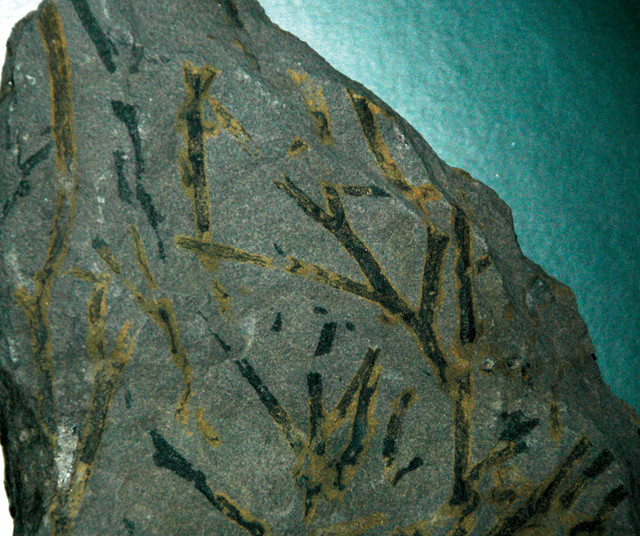
Fossil of Aneurophyton, a Devonian-aged plant. During the Devonian, Earth experienced its first "greening" of the land. The earliest land plants were small and simple and probably only grew close to bodies of water. By the Late Devonian, land plants had evolved large, tree-sized bodies and the first forests appeared. These are branches from an extinct group of vascular plants, the aneurophytalean progymnosperms. Progymnosperms have characteristics both of seed plants (wood, or secondary xylem) and of ferns (reproductive structures that produce spores). Credit: Field Museum of Natural History, James St. John, CC BY 2.0.

Fire in a pitch pine forest. Credit: Claire Belcher.
The carbon and oxygen cycles are tightly linked, a factor Kump says makes it even more important to understand the history of atmospheric oxygen. For example, it is thought that the climate was warming prior to the largest mass extinction of all time, the Permian-Triassic extinction event, which occurred about 252 million years ago and saw about 81 percent of marine species go extinct. “There is evidence that huge swaths of the oceans went anoxic,” Kump says. “How were changes in atmospheric oxygen content a part of that story too?”
Scientists think that the warming climate and greater volcanic activity may have impacted vegetation distribution during that time, and that the changing availability of fuel could have influenced wildfire activity. Markers in the geologic record have been found in China that suggest there was increased wildfire activity at the Permian-Triassic border, but it is unclear if this activity was global. There is also evidence of massive terrestrial erosion during this period. In a 2015 study in Frontiers in Plant Science, Glasspool and his co-authors analyzed coal deposits to track atmospheric oxygen levels during the late Paleozoic. They concluded that oxygen levels were high during the extinction event. “Perhaps the role of fire at the [Permian-Triassic] boundary, clearly … not a time of low oxygen, was greater than has currently been appreciated,” they wrote.
For now, scientists continue to explore the question of fire-mediated oxygen feedbacks through modeling and charcoal studies. “We also need better ways to measure oxygen,” Kump says, pointing to bubbles of trapped ancient air in salt deposits and amber as potential ways to get direct evidence of past atmospheric compositions. “There might also be other isotope systems that have oxygen fractionation sensitivities that we’re interested in,” he says. nbsp;
Wildfires are also thought to be a major driver of plant evolution. The earliest terrestrial plants of the Silurian and Early Devonian were small, primitive and herbaceous. This vegetation, though it could burn, mainly thrived in moist environments, so fires were likely small and infrequent across the land.
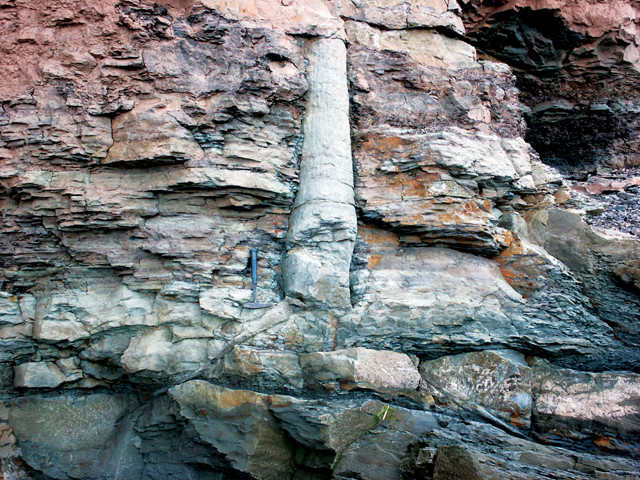
This lycopsid plant is from the Pennsylvanian Period. Lycopsid trees are thought to have evolved their thick bark, in part, to insulate against the heat from fires. Credit: Michael C. Rygel, CC BY-SA 3.0.
Over the next 40 million years, terrestrial flora evolved into new vegetation types, including trees. A rapid period of plant diversification during the late Paleozoic brought about the development of wood and leaves, which provided a new, ample fuel source. By the Late Carboniferous, a continuity of vegetation existed across the world for the first time. Charcoal records indicate that fire activity during this period was high, driven by high atmospheric oxygen levels and the arid conditions found within huge, land-locked sections of the supercontinent Pangea.
It’s during this time that seed plants — gymnosperms — rose to dominance. Spore-bearing plants had previously dominated Earth’s ecosystem, but they require more moisture to reproduce, and the increasingly arid climate made surface water scarcer. By the late Permian about 260 million years ago, gymnosperms made up 60 percent of Earth’s flora. As the variety and geographic range of plant types expanded across Earth, so too did the range of landscapes in which fire occurred. Fuel structure, such as leaf shape, size and moisture content, is an important element in fire propagation, and the growing variety of plant types produced diversity in fire regimes.
The co-evolution took on a new role from the late Paleozoic onward, as plants began to exhibit traits that were advantageous in fire-prone ecosystems. For example, during the highly flammable Carboniferous, lycopsid trees evolved thick bark, which helped insulate the trees against heat. Conifers, specifically Pinus, evolved thick bark about126 million years ago, during the high-fire period of the Cretaceous, and more than 100 million years after the first appearance of the species. By 89 million years ago, also during the flammable Cretaceous, these trees developed traits, such as branch shedding, to keep surface fires from reaching the crown, and serotinous cones, which are triggered by fire to release their seeds.
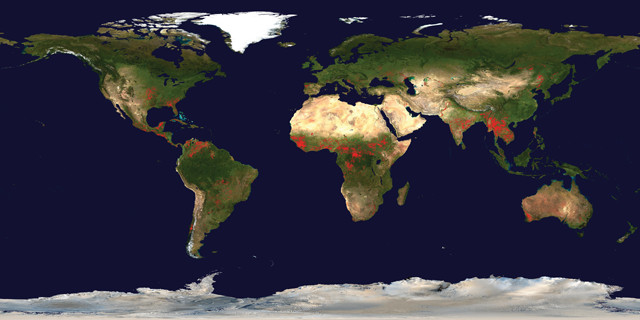
Locations of fires detected by the MODIS instruments on board the Terra and Aqua satellites over a 10-day period in August and September 2016. Credit: Fire maps by Jacques Descloitres, fire detection algorithm by Louis Giglio, Blue Marble background image by Reto Stokli.
It was also during the highly flammable Cretaceous that the dominant plant group of our world today — the flowering plants, or angiosperms— first gained a foothold on the landscape. Scientists think that the success of these plants may also be at least partially ascribed to fire. Angiosperms have a rapid life cycle and high productivity, and can out-compete slower-growing and slower-producing gymnosperms, wrote Belcher and co-author Victoria Hudspith, a research fellow in the wildFIRE lab at the University of Exeter, in a 2016 paper in New Phytologist. High burn activity during the Cretaceous may have cleared out gymnosperm forests and opened up ecological niches, facilitating the spread of fast-growing angiosperm invaders into forests cleared by fire, they wrote.
Our modern grass ecosystems have a similar relationship to fire today. Scientists think that fire maintains savannas that were previously established during drier times, even in areas wet enough today to sustain forests. Once grasses have colonized an area, they provide abundant dry-season fuel and can prompt feedbacks between fire and local climate that maintain and often encourage the spread of grasslands.
With our emerging understanding of fire’s impact on life comes a growing recognition that paleofire indicators and evidence are not without their shortcomings. For instance, different fire types leave variable charcoal residues behind. Low-temperature smoldering fires may leave behind more charcoal than hotter crown fires, a disparity with implications for how charcoal abundance actually correlates with wildfire activity and oxygen levels.
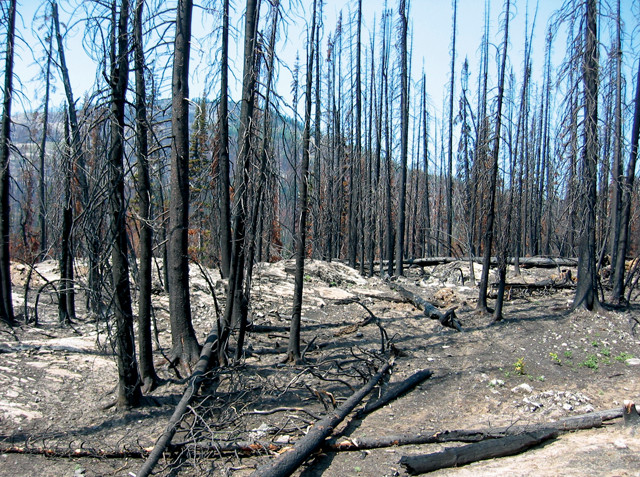
Ground vegetation is just beginning to return to this forest after a fire. Fire plays an important role in regulating and maintaining natural ecosystems. Credit: public domain.
Different fuels also produce different charcoal signatures, according to research published in 2017 in Geology by Hudspith and Belcher. They burned different types of flowering plants and found that combustion behavior and flower physiology affected the number of charred flowers produced, evidence that suggests that Cretaceous charcoal assemblages are unlikely to fully represent the plants present on the landscape at the time. This bias in charcoal formation and preservation complicates efforts to resolve the timing of angiosperm origins and diversification and the fossil record of fire, they wrote.
Fossil charcoal can reveal much about the environment in which it formed, from the specific plants that were burned, to the state of the planet’s atmosphere. But, according to Hudspith and Belcher, research across a range of modern ecological settings is critically needed to better understand the distribution of charcoal in the fossil record and what it says about fire’s role in shaping our planet.
There is abundant evidence that fire plays an important role in regulating and maintaining natural ecosystems, and there’s an argument to be made that we need to maintain the natural functioning of wildfire activity so that it can help keep the earth system within habitable bounds, Lenton says. “While human activity cannot significantly alter the amount of oxygen in the atmosphere, we are starting to deoxygenate the ocean,” he says. Natural processes like changing solar outputs, plate tectonics and climate change will continue to influence atmospheric oxygen levels over geologic timescales. But “human impacts, stemming from deforestation, massive increases in erosion rates and fertilizer use in agriculture, for example, could trigger disruptions like ocean anoxic events that could ultimately affect atmospheric composition too,” he says.
At a minimum, nailing down the planet’s fire history would give us an improved sense of the oxygen and carbon cycles through time, Kump says. “It’s important to develop those constraints for the broader implications of understanding the evolution of life on our planet.”
© 2008-2021. All rights reserved. Any copying, redistribution or retransmission of any of the contents of this service without the expressed written permission of the American Geosciences Institute is expressly prohibited. Click here for all copyright requests.